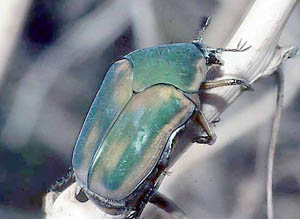Green June Beetle | |
|---|---|
| July 3, 2007 | |
|
Green June beetle adults are present throughout Illinois as far north as Peoria. These stocky beetles, about 1 inch long, are metallic green, with a couple of indistinct yellow stripes on the sides of the wing covers.  Green June beetle adult on stem. Green June beetle adult on stem.Adult green June beetles are active fliers during the sunny portions of the day, making a loud buzzing sound as they fly. They appear to fly toward upright, sunlit objects, including sheds, houses, and people. They seem to have a propensity for flying into people in the forehead, throat, or stomach. I have heard numerous stories of people being almost dazed by being hit by a beetle in the head, having trouble speaking for a while from being hit in the throat, and bending over in pain from a beetle hitting the stomach.  Green June beetle larvae. Green June beetle larvae.Larvae of green June beetles feed on dead grass. They are white grubs but are different from those that feed on turf roots, by not being C-shaped and being larger. They are white, with brown heads like white grubs, but grow to 1-1/2 to 2 inches long. Their legs are short, but they have relatively long, bristly setae (hairs) on their back. They are occasionally common in turf, where they tend to be more numerous under tree canopies. Although they do not feed on the live roots or other living portions of the grass, their burrowing through the thatch can loosen the roots, resulting in some dieback if populations are high. The larvae have a habit of coming out onto the turf surface at night to crawl around. In the process, they create holes in the soil surface about 1/2 inch in diameter, frequently with loose soil around them. A hundred or more of these larval emergence holes may be seen under a tree’s canopy. Their legs are apparently too short to be very useful aboveground. They get around by turning over on their back and using their long setae to move around with. The presence of large, white larvae crawling around at night on their backs can cause interesting telephone calls the next day from clientele. Typically, the call starts off with, “I swear I wasn’t drinking, but I saw . . . .” Green June beetle larvae become numerous in large quantities of dead grass, such as piles of grass clippings or used animal bedding at stables. This results in large numbers of beetles flying into people and other objects in these areas. The beetles fly from late June into late July. Control of green June beetles is most effective when aimed at the larvae, even though the adult beetles are the main problem. There are no practical controls for the adult beetles. The larvae are effectively controlled in turf with an application of carbaryl (Sevin) or any of the insecticides recommended for turf-damaging white grubs. The larvae are controlled in piles of grass clippings and manure by making them into compost piles. The resulting heat of decomposition kills all the grubs except those at the edge of the pile. |